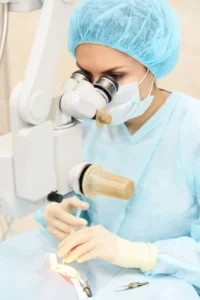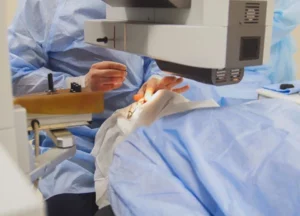In our fast-paced world where clear and sharp vision is key to leading a fulfilling life, eye health can no longer be sidelined. But here’s the good news: The progress in medical science has gifted us LASEK, a cutting-edge surgical procedure that offers a promising answer to vision impairments. If you’re tired of the constant bother of contact lenses and want to see clearly without glasses, LASEK eye surgery can be your path to a brighter, clearer future.
In this guide, we’ll demystify LASEK for you, taking you through its every aspect – from understanding what it is, its procedure, and who can benefit from it to the road to recovery post-surgery. Join us as we step into this exciting journey toward a clearer vision!
Contents
What is LASEK Eye Surgery?
Laser Assisted Sub-Epithelial Keratectomy (LASEK) is a progressive vision correction surgery aimed at treating common refractive errors such as myopia (nearsightedness), hyperopia (farsightedness), and astigmatism. The primary objective of LASEK is to reshape the cornea, the clear front surface of your eye, to improve the eye’s ability to focus light onto the retina, ultimately leading to a clear, crisp vision.
The distinctiveness of LASEK lies in its unique approach. Unlike LASIK, another popular eye surgery, LASEK does not create a corneal flap. Instead, it preserves the ultra-thin outer layer of the cornea, known as the epithelium, which is repositioned post-surgery. This process reduces the risk of certain complications, making LASEK an attractive choice for many individuals.
LASEK Surgery Procedure
 LASEK surgery involves a series of carefully orchestrated steps, ensuring precision and safety at every stage. Here’s a detailed rundown:
LASEK surgery involves a series of carefully orchestrated steps, ensuring precision and safety at every stage. Here’s a detailed rundown:
- Preparation: To begin with, your eye is numbed using topical anesthetic drops to ensure a pain-free experience. Following this, a device called a lid speculum is placed to keep your eyelids open throughout the procedure.
- Epithelium Removal: In the next step, a small amount of diluted alcohol solution is applied to the cornea. This solution loosens the epithelial cells, which are then carefully lifted and moved aside.
- Corneal Reshaping: This is the heart of the LASEK procedure. A state-of-the-art excimer laser is used to precisely reshape your cornea. The laser application is tailored to your unique vision prescription, ensuring that the treatment addresses your specific refractive errors.
- Repositioning the Epithelium: Once the corneal reshaping is complete, the surgeon carefully repositions the displaced epithelial cells back onto the cornea.
- Healing: The final step involves placing a protective bandage contact lens over your eye. This aids the healing process and provides comfort post-surgery.
Who Can Benefit From LASEK?
LASEK is an excellent option for individuals who may not be ideal candidates for other types of refractive surgeries such as LASIK. This includes patients with thinner corneas, those with professions or hobbies that expose their eyes to potential trauma, or those with dry eye syndrome.
Which Is Better LASIK or LASEK?
When it comes to vision correction procedures, LASIK (Laser-Assisted In Situ Keratomileusis) and LASEK are two of the most popular choices. Both methods have their advantages, but let’s delve deeper into why LASEK might be a superior choice for many individuals.
- Preserving the Corneal Surface – Unlike LASIK, which involves creating a thin flap on the cornea, LASEK preserves the cornea’s surface by only displacing the epithelium, the cornea’s outermost layer. This displacement is temporary, as the epithelial cells are carefully repositioned post-surgery. This technique avoids potential flap-related complications associated with LASIK, making LASEK a safer option for certain individuals.
- Suitable for Thin Corneas – Patients with thin corneas, who may not be eligible for LASIK, can often opt for LASEK. The absence of a corneal flap in LASEK means less corneal tissue is required for the procedure, making it a suitable alternative for those with thinner corneas.
- Decreased Risk of Dry Eyes – LASEK also poses a lower risk of post-operative dry eyes compared to LASIK. Dry eyes can occur when corneal nerves are cut during the creation of the LASIK flap, affecting the eye’s natural tear production. Since LASEK does not involve creating a flap, it preserves more corneal nerves, reducing the likelihood of dry eyes post-surgery.
- Ideal for Active Lifestyles – LASEK is often a better fit for individuals with active lifestyles or those engaged in contact sports. The absence of a corneal flap eliminates the risk of flap dislodgement due to trauma, which can be a concern with LASIK patients.
Is LASEK Eye Surgery Safe?
 When contemplating any form of surgery, safety is an essential aspect that cannot be overlooked. So, is LASEK safe? Let’s delve into this crucial question.
When contemplating any form of surgery, safety is an essential aspect that cannot be overlooked. So, is LASEK safe? Let’s delve into this crucial question.
In the landscape of refractive eye surgeries, LASEK has earned a reputation for being a safe and reliable procedure.
- It is an FDA-approved method for correcting vision and has been widely used across the globe with successful results.
- Unlike LASIK, LASEK doesn’t involve creating a corneal flap, reducing potential flap-related complications.
- The LASEK technique is particularly safe for individuals with thin corneas who may not be suitable for LASIK.
- The risks associated with LASEK are significantly mitigated when the procedure is conducted by experienced and skilled surgeons.
- Like any surgery, LASEK has some temporary side effects, including discomfort, light sensitivity, and dry eyes. These are typically short-lived and resolve as the eye heals post-surgery.
What Is The Success Rate Of LASEK?
LASEK holds a strong track record of success, promising a brighter and clearer visual future for many. Many studies reveal a high success rate for this procedure, both in terms of safety and effectiveness.
A large majority of patients undergoing LASEK achieve 20/40 vision or better, which is typically sufficient for most day-to-day activities. Even more impressively, a significant proportion achieve 20/20 vision or even better, highlighting the procedure’s efficacy.
Patients also report a high satisfaction rate post-LASEK. Many express a significant improvement in their quality of life, relishing the freedom from glasses or contact lenses. For many, the ability to wake up with a clear vision or enjoy sports without worrying about corrective eyewear proves life-changing.
It’s important to note that the definition of ‘success’ can be subjective and varies from patient to patient. For some, success means achieving a perfect vision without any need for corrective eyewear. For others, a reduction in their dependency on glasses or contact lenses marks a successful outcome.
The Side Effects of LASEK
 Despite the numerous benefits and high success rates of LASEK, it’s important to be aware of the potential side effects associated with the procedure. Understanding these side effects can help you make an informed decision about your vision correction journey.
Despite the numerous benefits and high success rates of LASEK, it’s important to be aware of the potential side effects associated with the procedure. Understanding these side effects can help you make an informed decision about your vision correction journey.
- Mild Discomfort and Irritation – Post-LASEK surgery, some patients might experience mild discomfort or a sensation of having something in their eye. This is a common side effect and typically subsides within a few days following the procedure.
- Sensitivity to Light – It is common for patients to experience sensitivity to light in the initial days following LASEK. While this can be slightly bothersome, it is temporary and typically resolves within a week.
- Dry Eyes – While LASEK reduces the risk of dry eyes compared to LASIK, some patients may still experience this side effect. This condition can cause a feeling of dryness or grittiness in the eyes and is generally temporary. Your doctor can manage this condition effectively with artificial tears or other medications.
- Visual Fluctuations – Some patients may encounter fluctuations in vision during the initial healing period. These can manifest as blurry vision, difficulties with night vision, or the appearance of halos or starbursts around lights. Again, these symptoms are typically temporary and improve as the eye heals and adapts post-surgery.
- Delayed Healing – Compared to other refractive surgeries like LASIK, LASEK may involve a slightly longer recovery period. This is due to the time it takes for the epithelial cells to heal and re-adhere to the underlying cornea.
Cost of LASEK Eye Surgery
Understanding the cost of LASEK is an important part of your vision correction journey. In India, the cost of LASEK eye surgery typically ranges from ₹30,000 to ₹70,000 per eye. However, this cost can vary depending on various factors including:
- The Surgeon’s Experience: More experienced surgeons may charge a higher fee due to their expertise and track record of success.
- Geographical Location: The cost of LASEK can also vary by region, with prices in metropolitan cities potentially being higher than in smaller towns.
- Technology Used: The type of laser technology used can influence the cost of the procedure. Advanced technologies may carry a higher price tag.
- Aftercare Services: Post-operative care services included in the total cost can also contribute to the price differences.
Conclusion
In the realm of vision correction, LASEK stands as a powerful tool to help you attain clearer, sharper vision. While both LASIK and LASEK have demonstrated high success rates and continue to improve the quality of life for millions worldwide.
At EyeMantra, we offer the most advanced LASIK options including PRK, Femto Lasik, SMILE surgery, Standard LASIK, ICL, and Contoura vision. If you have any questions on Lasik surgery in Delhi, Lasik surgery cost, and Lasik procedure, call us at 9711116605 or email at [email protected].


